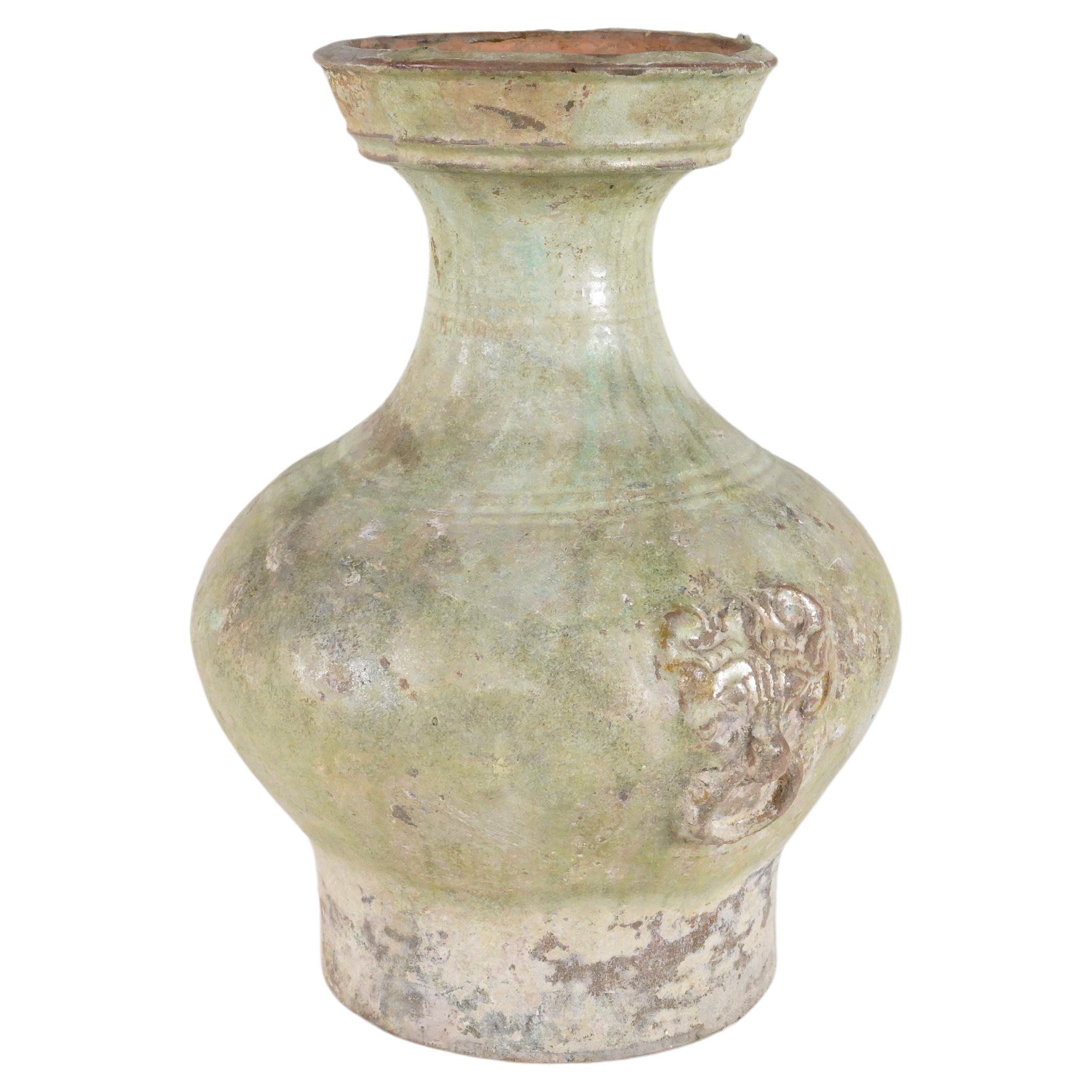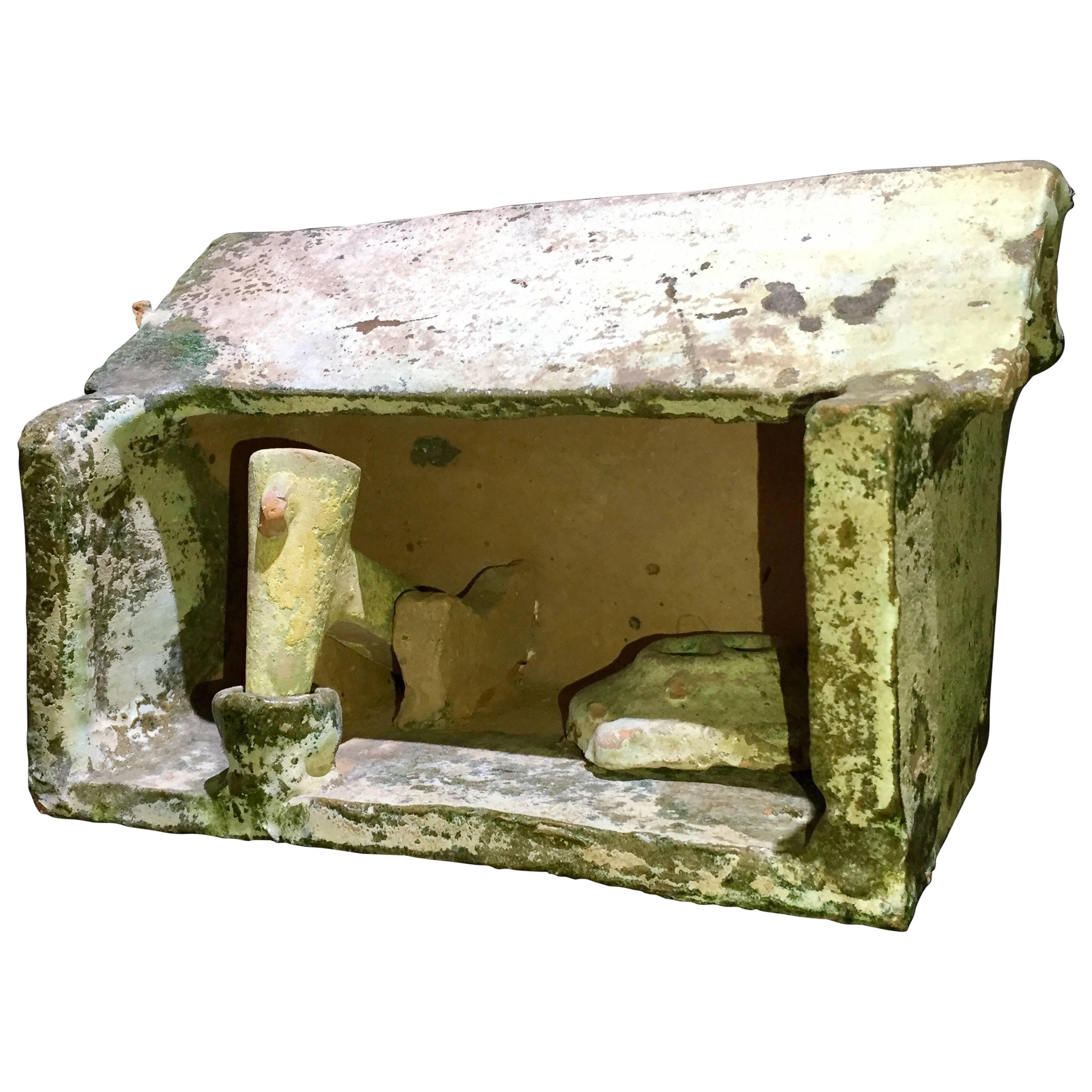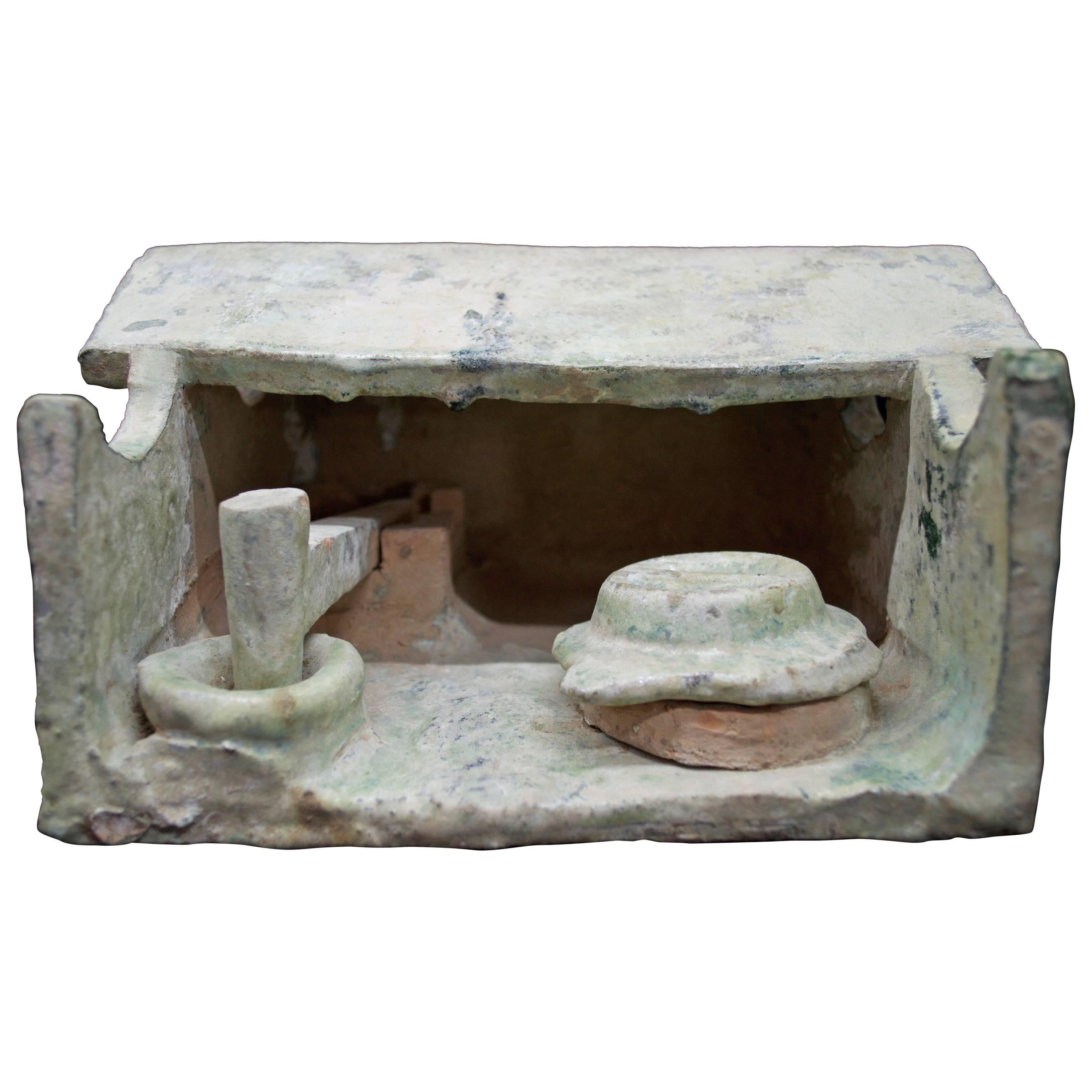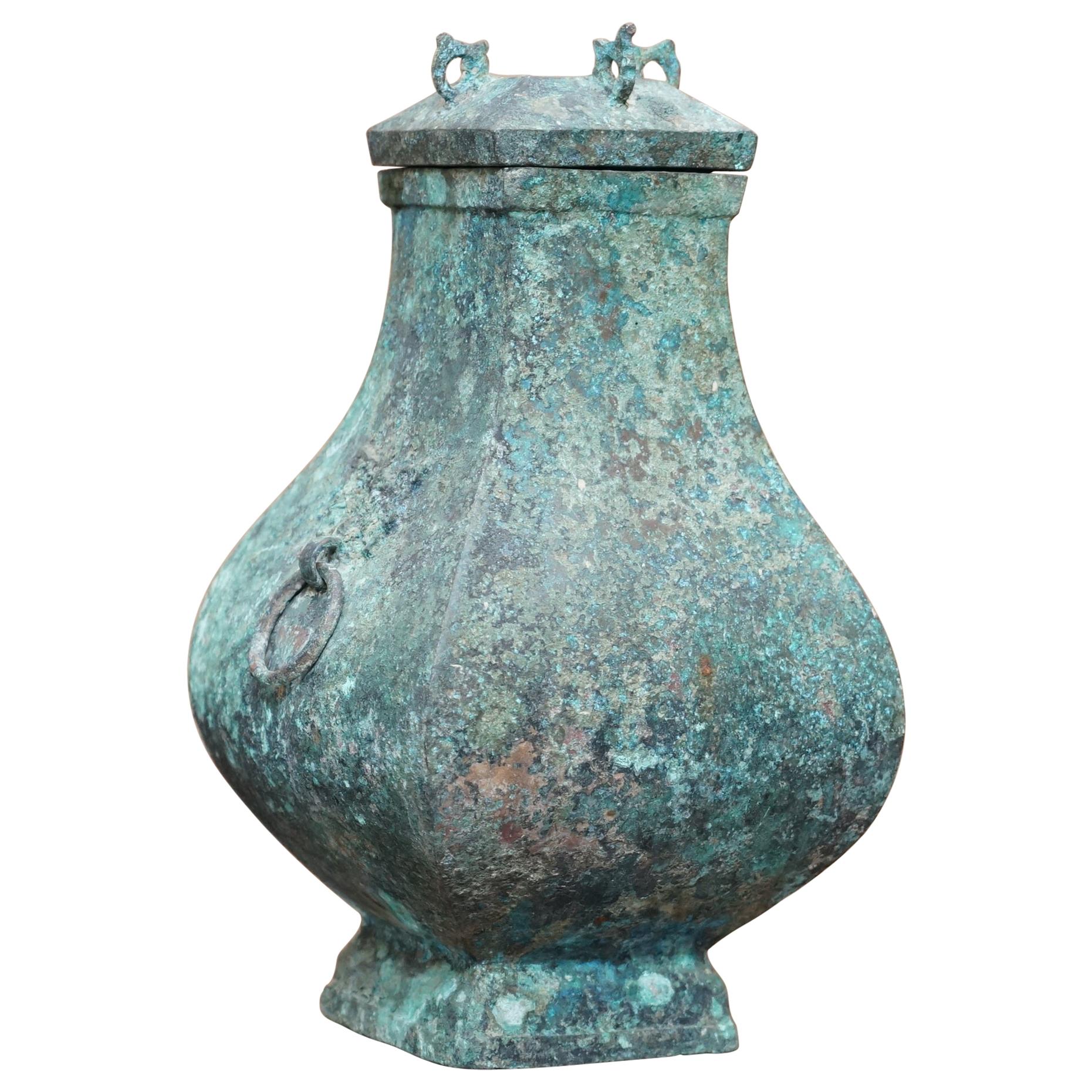Items Similar to Green-glazed pottery lampstand, Han Dynasty(206BC-220AD)
Want more images or videos?
Request additional images or videos from the seller
1 of 5
Green-glazed pottery lampstand, Han Dynasty(206BC-220AD)
About the Item
The upper section of the vessel is broad and flat, intended to support a candle or an oil lamp, while the stem and base are robust, designed for stability and durability. The surface is coated with a green glaze, which has matured over centuries to develop a distinctive patina, adding to its historical significance. This lamp stand is not only a testament to the daily life and practical needs of the Han Dynasty but also reflects the aesthetic values and artistic expression of the period.
Period : Han Dynasty (206 BC - 220 AD)
Type : Lamp Stand
Medium : Green glazed pottery
Provenance : The piece was acquired in Hong Kong in late 1990s.
Reference : Bonhams London 10 November 2016 - FINE CHINESE ART Lot 4
(Price Range : 5,000 GBP - 8,000 GBP / Type : Highly related)
* Han Dynasty Pottery
Han Dynasty pottery, originating from one of China's most significant historical periods (202 BCE – 220 CE), is renowned for its technological and artistic achievements in ceramic production. These artifacts typically feature a distinctive green glaze, although other colors were also used. The pottery often includes intricate decorative motifs, such as animals, mythological figures, and geometric patterns.
The craftsmanship during the Han Dynasty was advanced, with pottery techniques that were innovative for the time. These pieces were not only utilitarian but also held ceremonial and symbolic significance. The shapes and designs of Han Dynasty pottery vary, including items like urns, vases, and figures, reflecting both the daily life and the spiritual beliefs of the period.
- Dimensions:Height: 15.75 in (40 cm)Diameter: 6.3 in (16 cm)
- Style:Han (Of the Period)
- Materials and Techniques:Earthenware,Glazed
- Place of Origin:
- Period:
- Date of Manufacture:206BC-220AD
- Condition:Repaired: upper side of the column. Minor fading.
- Seller Location:seoul, KR
- Reference Number:1stDibs: LU9577237749132
About the Seller
New to 1stDibs
Joined in the past six months.
4.5
Vetted Seller
These experienced sellers undergo a comprehensive evaluation by our team of in-house experts.
Established in 1999
1stDibs seller since 2023
Typical response time: 1 hour
- ShippingRetrieving quote...Ships From: seoul, Korea South
- Return PolicyA return for this item may be initiated within 10 days of delivery.
More From This SellerView All
- Green-glazed pottery tripod 'hill' jar, Han Dynasty, 206 BC - 220 ADLocated in seoul, KRThe modelled animal figures and landscapes of this piece represent the Daoist ideology of the Han dynasty. The mountain-shaped lid refers to the sacred dwellings of the immortals, th...Category
Antique 15th Century and Earlier Chinese Han Antiquities
MaterialsStoneware
- Hu Shape Green-Glazed Vase, Han Dynasty(206 BC - 220 AD)Located in seoul, KRA 'Hu' is a type of large jar or pot that was commonly used in China for storage purposes, including holding liquids or dry goods like grains. This particular shape of pottery usually features a wide body and a narrow opening, and sometimes comes with a lid. The 'Hu' could also be more elongated with a slender neck, designed for easy pouring of liquids. The rainbow-like colors on this green-glazed surface come from changes that happen over hundreds of years while it's buried. This process is also known as "iridescence" and is often observed in ancient Chinese green pottery...Category
Antique 15th Century and Earlier Chinese Han Antiquities
MaterialsEarthenware
- Green-glazed pottery 'figural' lamp, Han DynastyLocated in seoul, KRThe lamp shaped as a kneeling female figure wearing long robes, her face with a large nose, deep-set eyes and pronounced cheeks, holding an infant in her lap, her cylindrical and elo...Category
Antique 15th Century and Earlier Chinese Han Antiquities
MaterialsEarthenware
- Milling Shed pottery with Green Glaze, Eastern Han DynastyLocated in seoul, KRMade from the standard orange earthenware body of Han green glazed tomb models, this miniature milling station features a circular millstone and a foot...Category
Antique 15th Century and Earlier Chinese Han Antiquities
MaterialsEarthenware, Pottery
- Green-Glazed Dish, Han DynastyLocated in seoul, KRThis Han Dynasty green-glazed dish exhibits significant signs of wear, indicative of its age and the long passage of time it has witnessed. The glaze, once vibrant, now shows substan...Category
Antique 15th Century and Earlier Chinese Han Antiquities
MaterialsEarthenware
- Green-Glazed Tripod Vessel, Han DynastyLocated in seoul, KRHan Dynasty green-glazed tripods are comparatively rare, especially ones that have retained their structural integrity and glaze over millennia. Pieces in good condition are scarce b...Category
Antique 15th Century and Earlier Chinese Han Antiquities
MaterialsEarthenware
You May Also Like
- A Han (206BC -220AD) Glazed Hu VesselLocated in Chicago, ILThis is a fine, heavily patinated example of a Han hu wine storage vessel, buried for the afterlife. The compressed globular body narrows to a slender waisted neck, covered with a da...Category
Antique 15th Century and Earlier Chinese Han Antiquities
MaterialsTerracotta
- Ancient China Monumental Stone Ram Han Dynasty, 206BC-220ADLocated in South Burlington, VTChina, a large votive model of a stone ram, Han dynasty (206BC-220AD) Dimensions: 45cm, 18 inches high and 65cm, 26 inches length and 25cm, 10 inches wi...Category
Antique 15th Century and Earlier Chinese Han Sculptures and Carvings
MaterialsLimestone
- Eastern Han Dynasty Terracotta Barn Workshop, China '206BC - 220AD' Ex-MuseumLocated in San Pedro Garza Garcia, Nuevo LeonSlab pottery constructed barn workshop having a peaked roof – open walled form with a mechanical pounder and a large round covered storage container. Light blue-green mottled glazed surface with some iridescence patina to the glaze. Condition: Intact, excellent condition, an unusual example. Provenance: The Living Torah Museum, Brooklyn; ex. Sands of Time, 2002. Sculptural effigies of domesticated animals were often interred in the tombs of nobility and elite members of the social hierarchy. Models like this one were made to represent everything from simple goat or pig pens to the most elaborate towers and palaces. Because very few ancient Chinese buildings have survived intact, these models, along with descriptions from ancient texts, give a good representation of what the buildings might have looked like. This fantastic piece is accompanied by a Certificate of Authenticity. Burial figurines of graceful dancers, mystical beasts, and everyday objects reveal both how people in early China approached death and how they lived. Since people viewed the afterlife as an extension of worldly life, these figurines, called mingqi, sometimes referred as “spirit utensils” or “vessels of ghosts” disclose details of routine existence and provide insights into belief systems over a thousand-year period. For the first time in Chinese history, we have images of rural and daily life during the Han in the form of contemporary...Category
Antique 15th Century and Earlier Chinese Han Antiquities
MaterialsTerracotta
- Eastern Han Dynasty Terracotta Model of a Paper Mill , China '206BC - 220AD'Located in San Pedro Garza Garcia, Nuevo LeonSlab pottery constructed Model of a Paper Mill, in Green and Cream Color Glazed Terracotta having a peaked roof – open walled form with a mechanical pounder and a large round storage container. Light blue-green mottled glazed surface with some iridescence patina to the glaze. The Iridescence is a refraction of the layers on the glass that produces multicolor hues & metallic luster, and only develops after one thousand years of being buried in the ground. An unquestionable mark of antiquity, impossible to falsify. Han Dynasty, dated 206 B.C-220 A.D. Condition: Excellent, wear commensurate with age, an unusual example. This fantastic piece is accompanied by a Certificate of Authenticity. Sculptural effigies of domesticated animals were often interred in the tombs of nobility and elite members of the social hierarchy. Models like this one were made to represent everything from simple goat or pig pens to the most elaborate towers and palaces. Because very few ancient Chinese buildings have survived intact, these models, along with descriptions from ancient texts, give a good representation of what the buildings might have looked like. Burial figurines of graceful dancers, mystical beasts, and everyday objects reveal both how people in early China approached death and how they lived. Since people viewed the afterlife as an extension of worldly life, these figurines, called mingqi, sometimes referred as “spirit utensils” or “vessels of ghosts” disclose details of routine existence and provide insights into belief systems over a thousand-year period. For the first time in Chinese history, we have images of rural and daily life during the Han in the form of contemporary records...Category
Antique 15th Century and Earlier Chinese Han Antiquities
MaterialsTerracotta
- Fanghu Han Dynasty 206BC-220AD Chinese Bronze Ritual Wine Vessel Jug & CoverLocated in GBWe are delighted to offer for sale this exceptionally important and highly collectable museum quality original Chinese bronze ritual wine vessel and...Category
Antique 15th Century and Earlier Chinese Han Antiquities
MaterialsBronze
- Pair of Red Sculpture Han Dynasty Gray Pottery Horse Heads '206BC-220AD'Located in Miami, FLPair of Chinese Han dynasty horse heads Han dynasty Style (206 BC-220 AD) earthenware gray pottery Each approximate measures: 6 inches high. 6...Category
Mid-20th Century Chinese Han Sculptures and Carvings
MaterialsTerracotta
Recently Viewed
View AllMore Ways To Browse
Chinese Han Dog
Antique Wicker Strollers Vintage
Living Room Glass Chandelier
Blue Rugs And Carpets
Table Lamps For Living Room
Solid Brass Furniture
All Art Glass
French Modern Designers
Marble And Bronze
Antique Red Carpets
Persian Rugs With Red
Polish Brass Table
20th Century Furniture New York
Mid Century Furniture New York
Turkish Rugs In Blue
1925 Furniture
Case Study Bedroom Furniture
Foot Object




